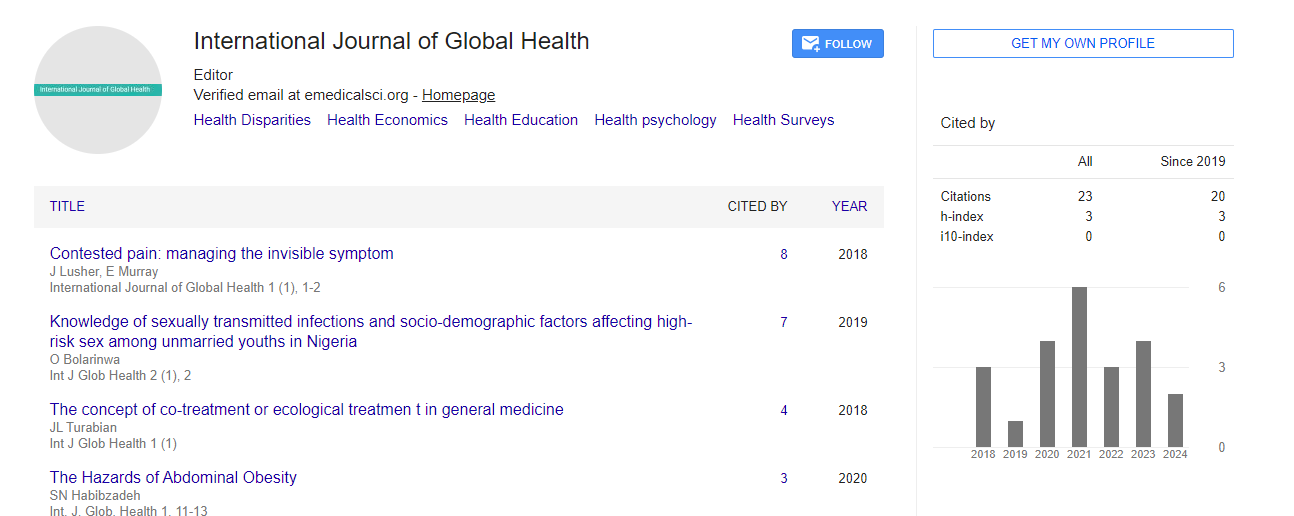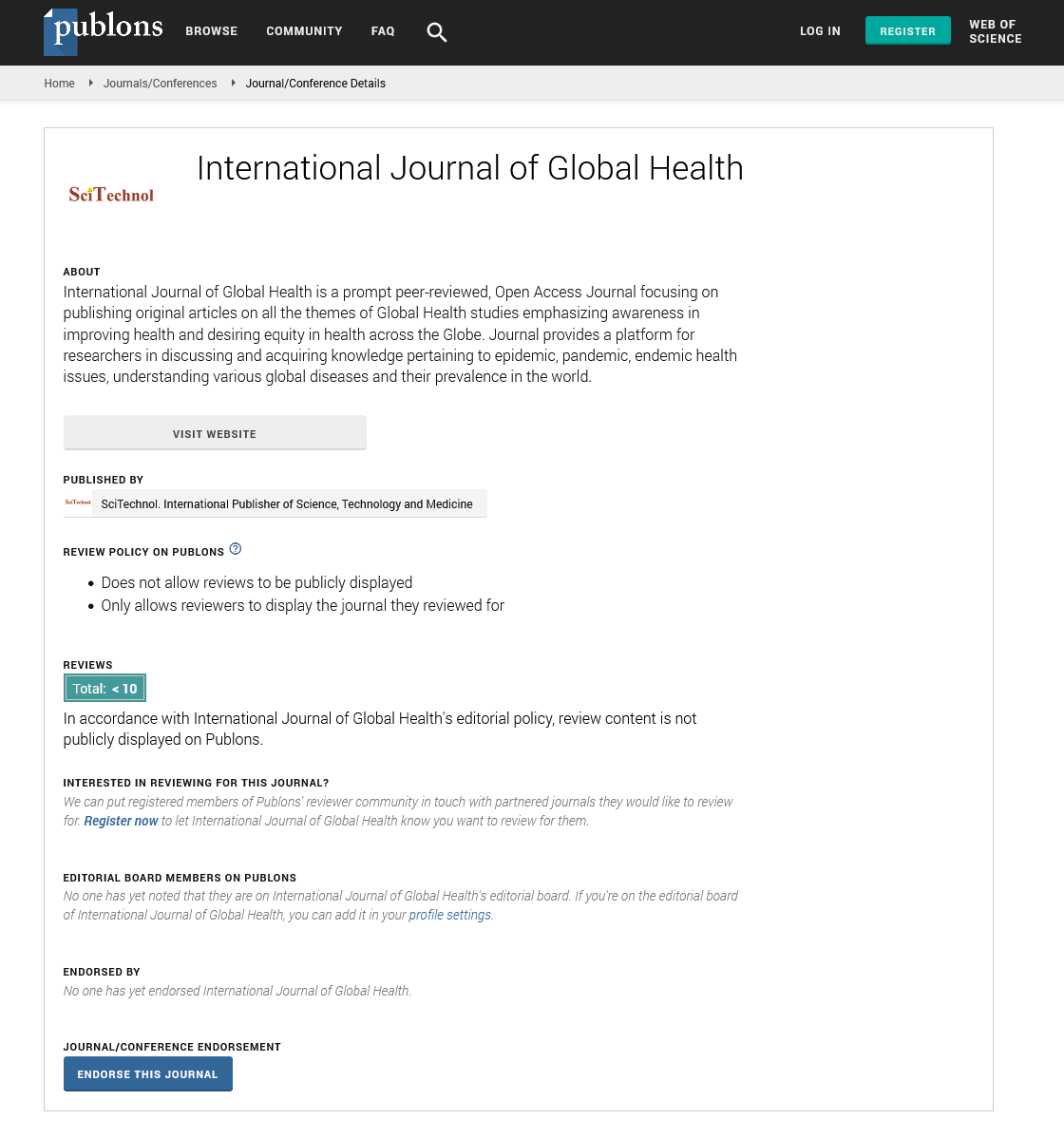Short Communication, Int J Glob Health Vol: 4 Issue: 5
Short Communication on Non-Communicable Diseases
Darla Lel*
Department of Urban Health and Health Care, Imam Abdulrahman Bin Faisal University, Dammam, Turkey
- *Corresponding Author:
- Darla Lel
Department of Urban Health and Health Care, Imam Abdulrahman Bin Faisal University, Dammam, Turkey
E-mail: leldarla8@gmail.com
Received Date: September 02, 2021; Accepted Date: September 16, 2021; Published Date: September 23, 2021
Citation: Lel D (2021) Short Communication on Non-Communicable Diseases. Int J Glob Health 4:5. 144.
Copyright: © All articles published in International Journal of Global Health are the property of SciTechnol, and is protected by copyright laws. Copyright © 2021, SciTechnol, All Rights Reserved.
Keywords: Urban Health ; Health Care ; Cardiovascular illness
Short Communication
A non-transmittable sickness (NCD) is an infection that isn’t contagious straightforwardly starting with one individual then onto the next. NCDs incorporate Parkinson’s infection, immune system illnesses, strokes, most heart sicknesses, most malignancies, diabetes, persistent kidney illness, osteoarthritis, osteoporosis, Alzheimer’s infection, waterfalls, and others. NCDs might be constant or intense. Most are non-irresistible, in spite of the fact that there are some non-transferable irresistible infections, for example, parasitic illnesses in which the parasite’s life cycle does exclude direct host-to-have transmission.
NCDs are the main source of death all around the world. In 2012, they caused 68% of all passings (38 million) up from 60% in 2000. About half were under age 70 and half were women. Risk factors like an individual’s experience, way of life and climate improve the probability of certain NCDs. Consistently, somewhere around 5 million individuals kick the bucket in light of tobacco use and about 2.8 million pass on from being overweight. Elevated cholesterol represents generally 2.6 million passings and 7.5 million bite the dust in light of hypertension [1].
Key Sicknesses
Malignancy
For by far most of tumors, hazard factors are natural or way of life related, accordingly diseases are generally preventable NCD. Greater than 30% of malignancy is preventable by means of staying away from hazard factors including: tobacco, being overweight or weight, low products of the soil admission, actual idleness, liquor, physically sent contaminations, and air pollution [2]. Infectious specialists are answerable for certain diseases, for example practically all cervical tumors are brought about by human papillomavirus contamination.
Cardiovascular illness
The main examinations on cardiovascular wellbeing were acted in 1949 by Jerry Morris utilizing word related wellbeing information and were distributed in 1958. The causes, counteraction, and additionally therapy of all types of cardiovascular infection stay dynamic fields of biomedical exploration, with many logical investigations being distributed consistently. A pattern has arisen, especially in the mid 2000s, in which various examinations have uncovered a connection between cheap food and an expansion in coronary illness. These examinations incorporate those led by the Ryan Mackey Memorial Research Institute, Harvard University and the Sydney Center for Cardiovascular Health. Many significant cheap food chains, especially Mcdonald’s, have fought the strategies utilized in these examinations and have reacted with better menu alternatives.
A genuinely ongoing accentuation is on the connection between poor quality irritation that trademarks atherosclerosis and its potential mediations. C-responsive protein (CRP) is a typical fiery marker that has been observed to be available in expanded levels in patients in danger for cardiovascular disease. Also osteoprotegerin which associated with guideline of a key incendiary record factor called NF- κB has been observed to be a danger factor of cardiovascular sickness and mortality [3].
Diabetes
Type 2 Diabetes Mellitus is an ongoing condition which is to a great extent preventable and reasonable yet hard to fix. The board focuses on keeping glucose levels as near ordinary (“euglycemia”) as conceivable without introducing unjustifiable patient risk. This can for the most part be with close dietary administration, exercise, and utilization of fitting prescriptions (insulin just on account of type 1 diabetes mellitus. Oral drugs might be utilized on account of type 2 diabetes, just as insulin).
Patient instruction, comprehension, and support is imperative since the difficulties of diabetes are undeniably more uncommon and less extreme in individuals who have all around oversaw glucose levels [4]. Wider medical conditions might speed up the pernicious impacts of diabetes. These incorporate smoking, raised cholesterol levels, corpulence, hypertension, and absence of standard exercise.
Persistent kidney illness
Albeit ongoing kidney illness (CKD) isn’t presently recognized as one of WHO’s principle focuses for worldwide NCD control, there is convincing proof that CKD isn’t just normal, unsafe and treatable yet in addition a significant contributing component to the frequency and results of no less than three of the infections designated by WHO (diabetes, hypertension and CVD). CKD firmly inclines to hypertension and CVD; diabetes, hypertension and CVD are on the whole significant reasons for CKD; and significant danger factors for diabetes, hypertension and CVD (like heftiness and smoking) additionally cause or compound CKD. Moreover, among individuals with diabetes, hypertension, or CVD, the subset who likewise have CKD are at most elevated danger of antagonistic results and high medical services costs. In this manner, CKD, diabetes and cardiovascular infection are firmly related conditions that frequently coincide; share normal danger variables and medicines; and would profit from an organized worldwide way to deal with avoidance and control.
Persistent Respiratory Illness
Persistent Respiratory Diseases (CRDs) are illnesses of the lungs and aviation routes. As indicated by the World Health Organization (WHO) a huge number of individuals experience the ill effects of CRDs. Common CRDs are: Asthma, Chronic obstructive aspiratory infection, Occupational lung illness, and Pulmonary hypertension.
While CRDs are not reparable, different therapies are accessible to assist with working on personal satisfaction for people who have them. Most medicines include widening major aviation routes to further develop windedness among other symptoms. The primary danger factors for creating CRDs are: tobacco smoking, indoor and outside air contamination, allergens, and word related risks [5].
WHO aided dispatch the Global Alliance against Chronic Respiratory Diseases (GARD) in 2006. GARD is deliberately made out of public and worldwide associations and runs after “diminishing the worldwide weight of ongoing respiratory sicknesses” and spotlight primarily on weak populaces and low and center pay countries.
References
- Danaei G, Vander HS, Lopez AD, Murray CJ, Ezzati M (2005) “Causes of cancer in the world: comparative risk assessment of nine behavioural and environmental risk factors”. Lancet 366 : 1784-1793.
- Morris JN, Crawford MD (1958) “Coronary heart disease and physical activity of work; evidence of a national necropsy survey”. Br Med J 2: 1485-1496.
- Karakas M, Koenig W (2009) “CRP in cardiovascular disease”. Herz 34: 607- 613.
- Lieb W, Gona P, Larson MG, Massaro JM, Lipinska I, et al. (2010) “Biomarkers of the osteoprotegerin pathway: clinical correlates, subclinical disease, incident cardiovascular disease, and mortality”. Arterioscler. Thromb Vasc Biol 30: 1849-1854.
- Nathan DM, Cleary PA, Backlund JY, Genuth SM, Lachin JM, et al. (2005) “Intensive diabetes treatment and cardiovascular disease in patients with type 1 diabetes”. N Engl J Med 353: 2643-2653. Author
 Spanish
Spanish  Chinese
Chinese  Russian
Russian  German
German  French
French  Japanese
Japanese  Portuguese
Portuguese  Hindi
Hindi 
